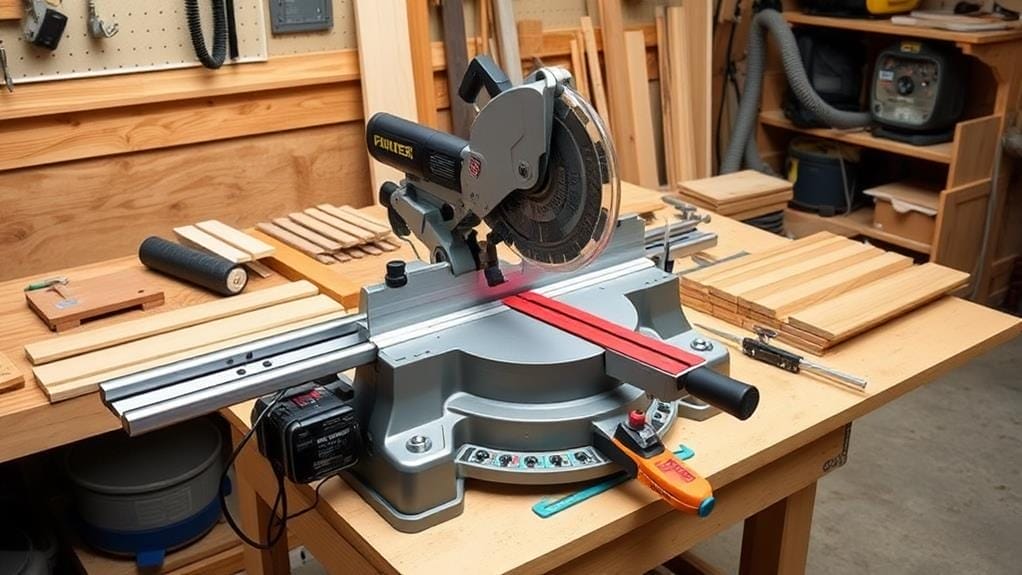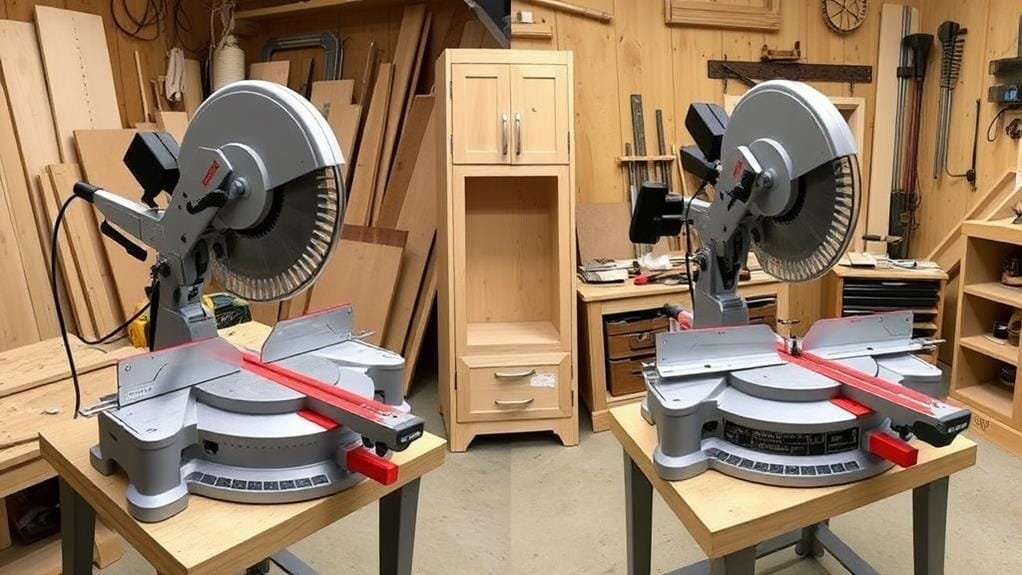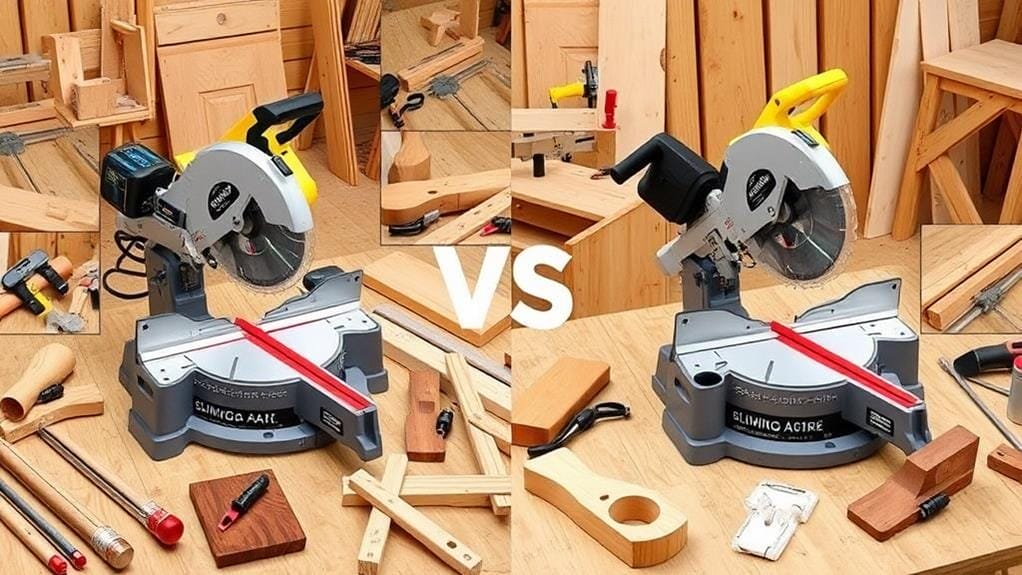Choosing between a sliding and non-sliding miter saw depends on your project's requirements. Consider the material size, project frequency, and workspace constraints to decide between the two options. Sliding miter saws offer greater cutting capacity and versatility, ideal for frequent, large-scale projects. Non-sliding miter saws are more portable, cost-effective, and suitable for smaller, occasional tasks. They can as well handle standard miter cuts. Moreover, think about your budget and the complexity of cuts you'll be making to choose the right tool for the job. If you invest in a miter saw, you'll learn more about proper maintenance, safety features, and how to get the most out of your tool by continuing with the guide.
Choosing the Right Miter Saw
When choosing the right miter saw, consider the type of projects you'll be working on and the size of the materials you'll be cutting. If you're working with wider materials or need to cut boards over 200mm, a sliding miter saw may be the way to go.
Nevertheless, if you're working on smaller projects with narrower boards, a non-sliding miter saw is likely a better fit.
Consider your workspace and mobility needs as well. Non-sliding miter saws are typically lighter and more portable, making them ideal for users with limited space or those who need to transport their tools frequently.
Conversely, sliding miter saws require additional clearance behind the saw for the sliding rails, which may not be feasible in compact workspaces.
Evaluate your budget and project needs carefully. Non-sliding miter saws are usually more cost-effective, while sliding miter saws provide increased cutting capacity and versatility for larger projects.
If you need to make precision cuts for complex angles and bevels, a sliding miter saw may be worth the investment.
Sliding Miter Saw Features
A key advantage of sliding miter saws is their ability to increase cutting capacity thanks to rails that allow the blade to move forward and backward. This feature allows you to cut boards wider than 200mm, making them ideal for larger projects like deck building and trim work.
You'll also appreciate the versatility of compound sliding miter saws, which can tilt for bevel cuts while also allowing for miter angles.
The improved sliding mechanism boosts accuracy and efficiency, especially for repetitive cuts, making them suitable for professional carpentry and construction work.
When choosing a sliding miter saw, look for models that incorporate advanced features like laser guides to improve cutting precision and assist quick positioning of workpieces. These features will help you achieve accurate cuts and increase your productivity.
Some key benefits of sliding miter saws include increased cutting capacity, improved accuracy, and greater versatility.
Non-Sliding Miter Saw Options

Non-sliding miter saws are often overlooked in favor of their more versatile sliding counterparts, but they offer numerous benefits that make them suitable for many users.
If you're a DIY enthusiast or a professional with limited workspace, a non-sliding miter saw might be the perfect fit for you.
For one, non-sliding miter saws are typically lighter and more portable, making them ideal for users who need to transport their tools frequently. A 10-inch non-sliding miter saw can cut a 2x6 at 90 degrees and a 2x4 at 45 degrees, providing adequate capacity for many home improvement projects.
They're likewise more cost-effective than sliding models, offering good value for users who undertake occasional tasks with narrower boards.
Non-sliding miter saws can still perform compound cuts, making them versatile enough for various applications such as trim work and framing.
Furthermore, their fixed head design requires less space during operation compared to sliding models, enhancing usability in small workshops.
Miter Saw Tables and Stands
Several miter saw tables and stands are available to provide essential support for boards on both sides, enhancing safety and stability during cuts. When choosing a miter saw, you may find that many come with stands, which can likewise be purchased separately.
These stands offer options for portability and ease of transport to job sites. Portable miter saw stands often feature foldable designs, making them convenient for storage and quick setup.
If you're a frequent user, building a dedicated miter saw table may be the way to go. This allows for a permanent workstation with additional storage for tools and materials.
You can also consider full miter saw stations that integrate other tools, enhancing functionality and efficiency for complex woodworking projects. These stations can include features like extra work surfaces, drawers, and cabinets.
By choosing the right miter saw table or stand, you can create a safe and efficient workspace that meets your specific needs and preferences. This, in turn, will help you achieve accurate cuts and successful woodworking projects.
With the right support, you can focus on your craft and produce high-quality results.
Key Considerations for Buyers

When choosing between sliding and non-sliding miter saws, consider what you'll be using them for - the types of projects, the materials involved, and your workspace. This will help you make a well-informed choice and guarantee you get the right tool for your needs.
Here are some key considerations to keep in mind:
- Material width: Think about the width of the materials you'll be cutting. If you work with wide boards or panels, a sliding miter saw is a better choice.
- Workspace constraints: Assess your workspace and consider the space required for a sliding miter saw. If you have limited space, a non-sliding saw might be a better fit.
- Budget: Evaluate your budget and consider the cost of the saw. Non-sliding miter saws are typically more affordable, while sliding models tend to be more expensive.
- Project complexity: Consider the complexity of your projects. If you work on intricate cuts or larger projects, a sliding miter saw offers more versatility and precision.
Benefits of Compound Sliding Saws
Compound sliding miter saws take their versatility and precision to the next level, making them a valuable asset for any woodworking or carpentry project. Their advanced features allow for more complex cuts, wider cutting capacities, and increased accuracy. Here's a breakdown of their benefits:
| Feature | Description | Benefit |
|---|---|---|
| Wider Cutting Capacity | Cuts materials up to 200mm wide | Ideal for shelving and crown molding projects |
| Dual Bevel Capability | Cuts both left and right angles | Boosts efficiency and reduces material flipping |
| Sliding Mechanism | Increases cutting capacity | Allows for more complex cuts and angles |
| Laser Cutting Guides | Provides a clear visual reference for positioning workpieces | Enhances accuracy and reduces errors |
These saws are designed for professional use, offering improved durability and better cutting performance compared to standard non-sliding models. With their advanced features and increased precision, compound sliding miter saws are perfect for complex woodworking projects.
Project Suitability and Tool Selection

Choosing the right miter saw for your project involves evaluating the specific needs and requirements of the task at hand. When deciding between a sliding and non-sliding miter saw, you'll want to contemplate the size and type of materials you'll be working with, in addition to the frequency and complexity of your projects.
If you're working on larger projects or with thicker materials, a sliding miter saw may be the better choice. Conversely, if you're working on smaller projects or with narrower boards, a non-sliding miter saw could be the way to go.
Here are some key factors to reflect upon:
- Material size: Sliding miter saws can handle larger materials, while non-sliding miter saws are better suited for smaller boards.
- Project frequency: If you're working on projects frequently, a sliding miter saw may be worth the investment, but if you only work on projects occasionally, a non-sliding miter saw could be a more cost-effective option.
- Portability: Non-sliding miter saws are typically lighter and more compact, making them easier to transport to job sites.
- Budget: Non-sliding miter saws are often less expensive than sliding miter saws, making them a good choice for those on a budget.
Frequently Asked Questions
Which Is Better, a Miter Saw or a Sliding Miter Saw?
You can't go wrong with a miter saw for precise angled cuts, but a sliding miter saw is better for wider boards and detailed woodworking tasks that require improved versatility.
What Is the Disadvantage of a Sliding Miter Saw?
When choosing a sliding miter saw, you'll find its disadvantages include decreased accuracy, added bulk and weight, complex maintenance, higher costs, and complicated setup and adjustments, potentially outweighing its benefits for your specific needs.
Is It Better to Push or Pull a Sliding Miter Saw?
When using a miter saw, you'll get better control by pushing it through the material rather than pulling it, as pushing provides more consistent downward pressure for cleaner cuts and reduced risk of binding.
What Is a Sliding Miter Saw Used For?
When deciding on a saw, you're probably wondering what a sliding miter saw is used for. It's primarily used for making wider cuts, ideal for larger projects like decking and cabinetry, and precise trim work.









